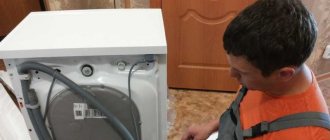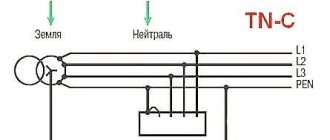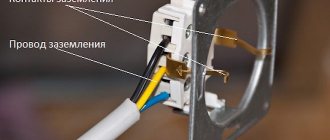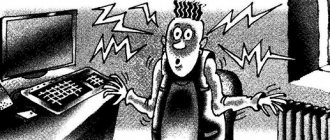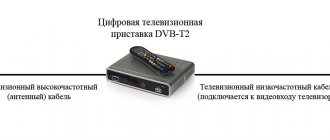Why is it necessary to ground your washing machine?
Many users, after purchasing a washing machine, boldly connect it to the nearest outlet and don’t even think about whether this is correct. First of all, you need to ground your washing machine for your safety.
Think about it! Even machines with a noise suppression filter installed are capable of passing current through the body - 110 Volts. And if the filter burns out or the wiring is broken, the electric shock can be 220 Volts. This is a direct threat to your health, and if installed in a damp room, life.
Moreover, if there is no grounding, the equipment itself may deteriorate. Contact of water with damaged wiring will lead to a short circuit and complete burnout of the washing machine. Think about what is more profitable: learning how to properly ground a washing machine or buying new equipment. Let's look at the features of installing grounding yourself.
Wiring around the house
To wire your home, you need a copper ground wire and a grounded outlet. The master places one end of the wire under the bolt of the distribution board busbar, and the other - to the grounding contact of the socket.
When you turn on the washing machine, use the indicator screwdriver. Using this tool, it is most convenient to trace the grounding. Press the screwdriver against the metal surface. If the indicator lights up, the equipment is not grounded.
All work with electrical devices must be carried out taking into account the standards and installations set out in the decree “Electrical equipment of residential and public buildings”.
You can easily find on the Internet photos and videos of masters who explain and show how to properly ground a washing machine in an apartment or private house. These materials will help you clarify the details if you are in doubt about a particular connection process. You can also look at the connection diagrams - they are in the public domain.
If you do not understand electrical safety, if you do not have experience working with grounding, it is better to entrust this work to professionals. Remember that carelessness can lead to disastrous consequences for you and for those who live nearby - you can cause an electric shock or fire.
It is best to entrust all work to professional electricians with electrical safety clearance. The access level speaks about the qualifications, knowledge and skills of the master. In addition, such a specialist will be responsible for the work performed. If you do the grounding yourself, without notifying the network organization, all responsibility for possible accidents will rest solely with you.
Grounding a washing machine in an apartment
The apartment has two grounding options. One of them is correct and allowed. The other is also often used by ordinary people, but is ineffective and “outlawed” today. We will talk about each of them so that you have an idea of the pros and cons of these methods. What tools will you need:
- Pliers;
- indicator screwdriver;
- tool to clean contacts.
Attention! Before starting work, unplug the machine.
First option: grounding in old houses
This method will tell you how to ground an outlet and a washing machine in an apartment if there is no grounding initially. Let’s immediately say that this option is suitable for residents of old houses, since in new buildings all sockets are equipped according to modern standards. Progress:
- It is necessary to organize wiring that will go to all household appliances, including lighting in the apartment.
- To do this, it is necessary to install two buses in the electrical panel, to which the wiring will later be connected. The buses are designated as zero - N, and with grounding - PE. How to connect the grounding to the shield, read on.
- A wire is drawn from the socket into which the SMA is connected to the panel. It should consist of three cores with a copper cross-section. The connection is made as shown in the photo below.
First connect the blue neutral wire, which is connected to the N bus. Then connect the ground wire to the PE bus, in different cases it may be green or yellow. Now the red phase wire is connected to the RCD of the meter.
Note! It is forbidden to swap contacts.
This way you can protect yourself and your equipment. If you are afraid to carry out such work, then call an electrician.
Second option: grounding in the bathroom
How to install grounding on a washing machine in the bathroom if there are no special contacts on the panel? Use the potential equalization method. The fact is that in the bathroom there are a lot of objects that conduct electric current. To receive a small electrical discharge, you do not have to touch the SMA body - just touch the mixer. We propose to connect all objects that conduct current with metal wires - thus equalizing the potential.
When placing the SMA in the bathroom, it is necessary to install moisture-proof sockets.
However, this is not enough. For a washing machine without grounding, an RCD is additionally installed. An automatic shield is also required. In case of failures and overloads, the shield will simply be knocked out, which will protect your equipment from damage. Of course, it could not have happened without home craftsmen who came up with their own method of equalization. It is much cheaper, just as effective, but it is against safety regulations and has its drawbacks. In this case, the grounding wire of the washing machine is fixed to a metal pipe or battery.
A rather dubious option, since pipes quickly collapse under the influence of electricity. This will entail additional costs for their replacement.
Many people doubt: is it possible to zero a washing machine? This question is relevant when there is no ground wire on the panel. In this case, there is an option to connect the wire to the zero phase. However, this method is not safe. It's up to you to decide which option to use in your apartment. One thing is for sure - a washing machine without grounding will sooner or later cause unpleasant situations.
Grounding methods
Let's highlight the main options for grounding a washing machine in a bathroom or other room.
- Connecting the housing to sewerage, water supply or batteries.
- The output of a personal socket for which the ground wire is connected from the access panel.
- Creation of a system that equalizes the potential of equipment in the apartment.
- Switching on at the RCD input.
- Making your own ground loop. The last option is suitable for cases when a person lives in a private house.
Many people make the mistake and choose the first option. Theoretically, he is working, but his own salvation may result in the following consequences:
- In the event of a breakdown on the housing and poor grounding of the elements, the potential appears on the plumbing system or battery. As a result, people (residents of other apartments) who touch the metal part at this moment may be injured.
- This method of grounding accelerates the process of metal destruction. As a result, the pipe is damaged more quickly, and the risk of flooding your neighbors and your apartment is high.
In addition, PUE and PTE prohibit this method of grounding, so it should be abandoned.
The best way is to connect a separate outlet to which a grounded wire is connected from the driveway panel. This option is suitable for cases where the house has a grounding loop (some old multi-story buildings do not have one).
The difficulty is not to confuse the working zero and the ground. If you make a mistake and connect the wire to a phase, a short-circuit current will flow in the circuit. The result is the disconnection of the power supply at the entrance (for one phase). In addition, there is a high risk of getting burned.
Another way is to connect an additional wire to a metal grounded busbar, which is grounded and runs along all floors, and then “tightly” connect the wire to the body of the washing machine.
The downside of this option is that you will have to damage the integrity of the equipment casing, and the appearance of the household appliance will deteriorate.
Solving the potential equation involves performing the following actions. The housings of metal devices in an apartment (house) are connected to each other by current-carrying elements (wires). There is a uniform distribution of potential.
If a phase hits the ground, the potential will pass along the path of minimal resistance and will not go through the human body. There is nothing complicated in implementing the scheme, so it is easy to do it yourself.
If there is no grounding in a private house or apartment and a conductor with two cores is laid, you should choose an alternative option - install an RCD or a circuit breaker at the entrance to the apartment.
Grounding a machine in a private house
If it is important for you to know how to ground a washing machine in a private house, then you can do this in the same way as in an apartment - follow the methods described above. However, there is another option.
Residents of the private sector can independently organize grounding on the street. To do this, select a free area in the yard. You will need three metal pipes. Typically, pipes from old beds with a length of at least 1.5 meters are used for these purposes. Next, do this:
- Install the pipes in the ground to a depth of at least 2 meters. The distance between them should be from one to one and a half meters.
- The installation is carried out so that 15 centimeters of the pipe remain protruding above the ground. Metal plates are welded to them.
- A grounding wire is connected to this structure and welded to one of the plates.
- The other end of the wire is brought to the distribution panel and connected to the PE bus (grounding).
If your washer has a special bolt, you can run the wire to it, and not to the shield. There are times when a machine receives an electric shock due to a breakdown. Therefore, before starting work, inspect the washing machine for damage to the wiring. After all, if you do not replace the damaged area, there is simply no point in carrying out the work. Grounding in any room must be organized using three-wire wires. They should be routed from the panel to all sockets. The remaining options, although effective, are dangerous to health. If you do not understand electricians, it is better to call a specialist to your home. For those who decide to work independently, a video on the topic:
Grounding the washing machine in the apartment
The method of connecting a washing machine in an apartment in a multi-storey building depends on the year the building was built. If the house was built recently and belongs to the category of new buildings, finding a grounded busbar in the panel will not be a problem.
Moreover, many houses are built taking into account each apartment, and the wires are laid with three cores.
Household appliances (washing machine, microwave oven and other equipment) have a wire with three cores, so safety is guaranteed.
If the building was erected before 1990, it is worth carefully examining the panel for the presence of a grounding busbar.
There are two ways to ground a washing machine: do the work yourself or use the services of an electrician.
When connecting independently, the algorithm of actions is as follows:
Next, all that remains is to install the outlet and connect it. This requires a socket, an indicator screwdriver, pliers, a cable with three cores, a knife and a socket with a grounding terminal. If the considered set of works seems complicated, you should entrust the work to a master.
READ MORE: How to install an outlet in the bathroom.
How to connect a washing machine if there is no ground?
Whatever one may say, the most adequate solution would be to connect through an RCD without grounding and other tricks. You need to understand that differential current protection (RCD or differential circuit breaker) does not guarantee protection against electric shocks. But these devices will turn off the voltage if you start to “pinch” decently. The fact is that without a “ground”, if any leakage occurs, a minimum current is required to trigger the RCD and a person can become a link in this chain.
In other words, before turning off you will still get an electric shock, but only briefly. This is much safer than no protection at all. Perhaps the protection will periodically work, seemingly for no reason - this indicates dampness inside the machine or a malfunction.
It is worth noting that the RCD is unlikely to protect against currents from the midpoint of the input capacitors.
Selecting a residual current switch (RCD) or a residual current circuit breaker (residual current switch) does not make any difference. The main thing to remember is that the RCD does not protect against normal overload or short circuit, so a regular machine is installed in series with it.
Leakage or differential current response rating ( IΔn
on the body) you need to select 10 mA or 30 mA. At 10 mA it is theoretically safer, but the protection may falsely trip more often.
RCDs of both electromechanical and electronic types are suitable for protection. However, the electromechanical type is preferable - it remains operational even if the zero is broken. But such devices are more expensive and more difficult to find on sale.
Well, the last piece of advice on RCDs: structurally, this device is designed for installation in a switchboard, which is where it actually belongs. However, with the old Soviet wiring in the electrical panel there is no separate branch for the washing machine; often 1-2 machines are installed for the entire apartment. Therefore, the protection should be installed on the branch that includes the socket for the machine.
